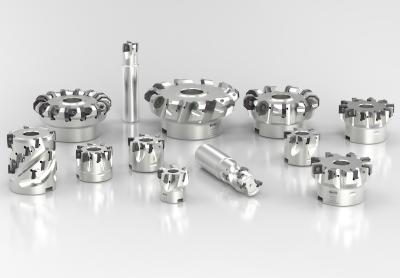
MAPAL has introduced a milling program with pressed, radial, ISO indexable inserts, thus completing the portfolio of standard milling tools. Up to now, the company has mainly focused on a milling program with ground, tangential, ISO indexable inserts. These are used in particular for special applications, very large stock removal, unstable conditions or disc milling cutters.
MAPAL has incorporated the comprehensive know-how gathered in these special applications into the new series of milling cutters with radial ISO indexable inserts. The new face, shoulder, slot and shell end facemilling cutters are designed for roughing and for medium machining of cast iron, steel and stainless steel. They have optimally designed tool bodies with the ideal number of teeth for the respective application. Positive and negative indexable inserts made of four different PVD cutting materials, based on newly developed carbide substrates and coatings, are available for the milling cutters.
Depending on the requirement, the most economical version is used. For example, between eight and 16 cutting edges per radial ISO indexable insert can be selected for facemilling and between two, four and eight cutting edges for shoulder milling.
The new tools are convincing in use due to their smooth running and low noise. In addition, long tool lives are achieved due to the possibilities for exact adjustment to the respective material and the respective application.
Contact Details
Related Glossary Terms
- facemilling
facemilling
Form of milling that produces a flat surface generally at right angles to the rotating axis of a cutter having teeth or inserts both on its periphery and on its end face.
- gang cutting ( milling)
gang cutting ( milling)
Machining with several cutters mounted on a single arbor, generally for simultaneous cutting.
- indexable insert
indexable insert
Replaceable tool that clamps into a tool body, drill, mill or other cutter body designed to accommodate inserts. Most inserts are made of cemented carbide. Often they are coated with a hard material. Other insert materials are ceramic, cermet, polycrystalline cubic boron nitride and polycrystalline diamond. The insert is used until dull, then indexed, or turned, to expose a fresh cutting edge. When the entire insert is dull, it is usually discarded. Some inserts can be resharpened.
- milling
milling
Machining operation in which metal or other material is removed by applying power to a rotating cutter. In vertical milling, the cutting tool is mounted vertically on the spindle. In horizontal milling, the cutting tool is mounted horizontally, either directly on the spindle or on an arbor. Horizontal milling is further broken down into conventional milling, where the cutter rotates opposite the direction of feed, or “up” into the workpiece; and climb milling, where the cutter rotates in the direction of feed, or “down” into the workpiece. Milling operations include plane or surface milling, endmilling, facemilling, angle milling, form milling and profiling.
- physical vapor deposition ( PVD)
physical vapor deposition ( PVD)
Tool-coating process performed at low temperature (500° C), compared to chemical vapor deposition (1,000° C). Employs electric field to generate necessary heat for depositing coating on a tool’s surface. See CVD, chemical vapor deposition.
